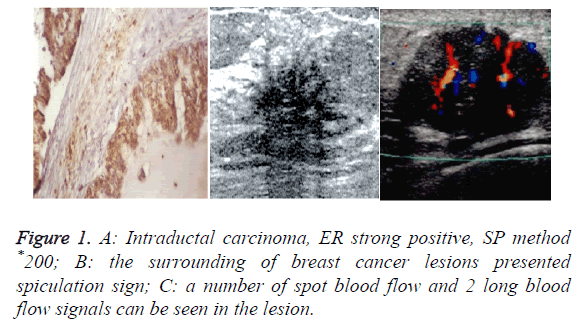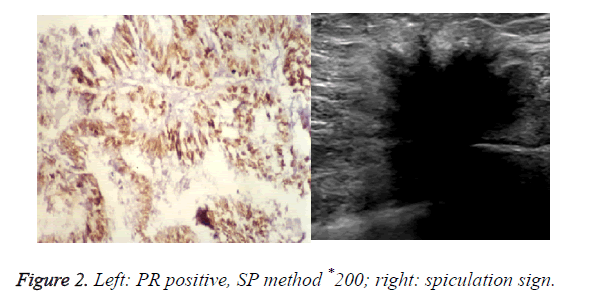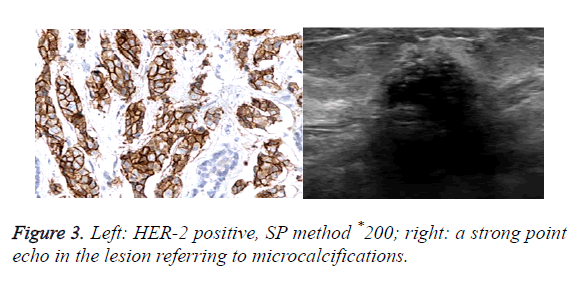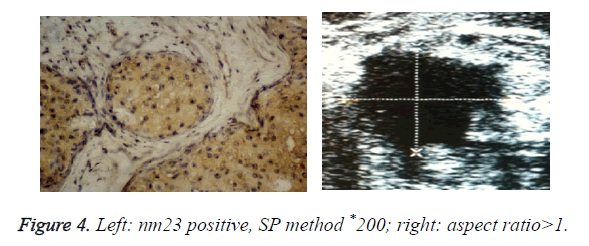ISSN: 0970-938X (Print) | 0976-1683 (Electronic)
Biomedical Research
An International Journal of Medical Sciences
Research Article - Biomedical Research (2017) Volume 28, Issue 13
Study on the correlation between ultrasonic imaging features in breast cancer and the expression of ER, PR, HER-2 and nm23
Shu-Ping Zhang1#, Wei Wang2*#, Yang Gu1, Lan Jin1 and Fang Zhou2
1Department of Ultrasound, Baoji Hospital of Traditional Chinese Medicine, Shaanxi, PR China
2Baoji Maternal and Child Health Care Hospital of Shaanxi, PR China
#These authors contributed equally to this work
- *Corresponding Author:
- Wei Wang
Baoji Maternal and Child Health Care Hospital of Shaanxi
Shaanxi, PR China
Accepted on May 25, 2017
Objective: To investigate the ultrasonographic features of breast cancer, and analyse its correlation with ER, PR, HER-2 and nm23.
Methods: Female patients with breast cancer from January 2015 to December 2016 were selected and retrospectively analysed ultrasound imaging performance in accordance with the inclusion criteria. And immunohistochemical method was used to detect the expression of ER, PR, HER-2 and nm23 in pathological specimens to analyse its correlation with ultrasonic imaging features.
Results: The positive rate of ER, PR in patients with spiculation in the lumps’ edge was significantly higher than that of patients with no spiculation in the lumps’ edge (P<0.05). The positive rate of PR in lumps<2 cm was significantly higher than that of the large lumps (P<0.05); the positive rate of ER, nm23 in patients whose blood flow was grades 0-I was significantly higher than that of grades II-III (P<0.05). The positive rate of HER-2 in the patients with microcalcification in the lumps was significantly higher than that without calcification (P<0.05); the positive rate of nm23 in patients with aspect ratio>1 in the lumps was greater than that of patients with aspect ratio ≤ 1 (P<0.05). Whether the lesion of breast cancer had rear echo increased or not had no significant relationship with the positive rate of ER, PR, HER-2 and nm23.
Conclusion: There is correlation between ultrasonic performance in breast cancer and the expression of ER, PR, HER-2 and nm23, and through the features of ultrasound, the expression of ER, PR, HER-2 and nm23 in lesion of tumor can be partly estimated.
Keywords
Breast cancer, Ultrasound imaging, ER, PR, HER-2, nm23.
Introduction
Breast cancer has become one of the most common female malignant tumors in the world. According to the 2012th statistical data issued by Word Health Organization; the newly diagnosed cases of world-wide female malignant tumor in are of 1.7 million, occupying 25% of the total female malignant tumor in morbidity, with cases of death of 521.9 thousand, which occupying 15% of the total cases of death of female malignant tumor, and with the change of life style, the incidence of female breast cancer increased significantly in China [1]. According to the third nationwide death inquiry, the standardized death rate is climbing up from 39.9/100 thousand to 53.6/100 thousand during 1944~2013, with an average rate of rise of 1.4% [2]. So the prevention and treatment of breast cancer is urgent and early detection, early diagnosis and early treatment have significant influence on the prognosis of breast cancer, which can improve the survival rate and prolong the survival time of the patients [3,4]. The occurrence and development of breast cancer is produced by the interaction of multiple factors, and variation of oncogenes and tumor suppressor genes and expression disorders of steroid hormones (such as estrogen ER) are both important factors for the occurrence and development of tumor. The molecular markers of currently mature study are ER (Estrogen), PR (Progesterone), HER-2 (human epidermal growth factor receptor 2), nm23, which has an important significance to judge the progression and prognosis of breast cancer. The ultrasonic tomography examination regularly applied in clinic is a widely used examination method for breast diseases, which is easy for operation, safe, economical and practical, that can decide the inner structure of the tumor, the blood supply and the relations between tissues around [5]. But the correlation between ultrasonic imaging features in breast cancer and the expression of ER, PR, HER-2 and nm23 is still not very clear, thus, this study aims to investigate the ultrasonic imaging features of breast cancer, and analyse its correlation between ER, PR, HER-2 and nm23 in order to provide strong basis for clinical diagnosis and treatment and prognosis judgment.
Materials and Methods
The research object
Female patients with breast cancer in our hospital from January 2015 to December 2016 were selected, and all patients underwent routine ultrasound examination and were diagnosed with breast cancer by pathology. Inclusion criteria [6]: patients underwent preoperative high frequency ultrasonography; patients were not given radiotherapy and chemotherapy or endocrine therapy before ultrasound examination and surgery and were not in the period of pregnancy or lactation; all patients underwent surgical resection in our hospital and had histopathological results. The following conditions of cases were excluded: no tumor found through ultrasound examination; ultrasound image acquisition was not ideal (The above contents were excluded for the reason that this research study mainly on the correlation between ultrasonic tomography examination and molecular markers, therefore, although based on pathological examination, cases in which no tumor were found through ultrasonic tomography examination or image acquisition was not ideal should be excluded); the lack of complete pathology and histological data; there are dysfunction of other systems. A total of 150 patients met the above standard, aged 30-75 y old with average age (50.2 ± 6.3 y) old. Among them, 110 cases were invasive carcinoma, 20 cases were mixed carcinoma, and 20 cases were mucinous carcinoma.
Ultrasonic inspection method
PHILIPS-IU22 color Doppler ultrasound diagnostic apparatus was adopted for breast examination. Patients were in the supine or left and right lateral position, and the probe frequency was 6.0-15 MHz for comprehensive scanning in the breast and axillary area. After the tumor was found, multiple scanning should be conducted to clearly show the ultrasound imaging of the lump. The lumps’ site, number, shape and size (multisection observation, and maximum diameter acquisition), and the peripheral and internal blood of lesions, edge burr or not, rear echo or not, calcification and axillary lymph node enlargement were detected. Three doctors with 10 y of experience with ultrasonography evaluated in the inspection process, once the divergence appeared, agreement should be reached after the discussion. Ultrasonic image of breast cancer mainly shows irregularly formed hypoechoic nodule, accompanied with less hyperechogenicity nodule; lobulated and rag shape can be seen changed on the rim, inner calcification of psammoma bodies is the characteristic changes of breast cancer.
Immunohistochemical detection
The tissue sections which were consistent with pathological result were taken and independently judged by two experienced pathologists with all samples detected by using immunohistochemical staining. The pathological tissues were taken and in sections were embedded with paraffin. xylene and ethanol were used for dewaxing with citric acid repairing for 2 min 30 s; PBS filming for three times; after PBS filming, diluted first resistance was added in water bath box for 20 min incubating at 37°C, anti-dilution, 37°C were stirred with 20 min; PBS rinsed 3 times; DAB color liquid was dropped and observed under the microscope; hematoxylin for staining again, 0.1% hydrochloric acid alcohol for differentiation; tap water flushing; xylene for vitrification and balata mounting.
The judgment criteria of immunohistochemistry results
Observed under the 200 times light microscope, 3 slices were chosen from each specimen with 5 views randomly chosen from each slice to record cell staining situation. Among them, those with mammary epithelial cell nuclei having brown yellow particles were ER, PR positive, and nm23 expressed in the cytoplasm presenting brownish yellow referred to positive expression. The percentage of positive cells of each view in the total observed cells number was calculated with the average value as the percentage of positive cells. Weakly positive was expressed as 1 point, which meant that the number of positive cells was 1%-10%; medium positive was 2 points, referring to the number of positive cells was 11%-50%; positive was 3 points, meaning the number of positive cells was 51-80%, strong positive was 4 points, referring to the number of positive cells>80%. According to the degree of color in positive cells, they were divided into: 1 point: cells with light colored presenting pale yellow; 2 points: cell with stained as brown; 3 points: cells were colored significantly as yellowish brown. The final calculation of both was carried out. <1 point: negative; 2 points: weak positive (+); 3-4 points: positive (++); 5-6 points: strong positive (+++). HER-2 stained in the cell membrane, negative: cell membrane with no coloring or <1% cancer cells coloring; +: weak coloring or cell membrane coloring<10%; ++: coloring slightly clear with most complete, coloring cell>10%; +++: cancer cell membrane has complete strong coloring and coloring cells>10%.
Statistical analysis
All the data were statistically processed by SPSS 19 statistical software, χ2 test was used for count data, and the correlation between groups was analysed by Spearman rank correlation analysis with P>0.05 for the statistically significant difference.
Results
Correlation between ultrasound image features and the expression of ER
The positive expression rate of ER in breast cancer was 68% (102/150). The positive rate of ER in patients with spiculation in the lumps’ edge was significantly higher than that of patients with no spiculation in the lumps’ edge (P<0.05). And the positive rate of ER in patients whose blood flow was grades 0-I was significantly higher than that of grades II-III (P<0.05) with the differences having statistical significance. The positive rate of ER in lumps ≤ 2 cm was significantly higher than that of the large lumps>2 cm (P<0.05) with the differences having no statistical significance. Breast cancer’s lesion size, aspect ratio, calcification or not, rear echo increased or not had no significant relationship between the positive rate of ER (P>0.05), as shown in Table 1 and Figure 1.
| Ultrasonic imaging features | n | ER positive | PR positive | HER-2 positive | nm23 positive | |||||
|---|---|---|---|---|---|---|---|---|---|---|
| N | P | N | P | N | P | N | P | |||
| Lesions size | ≤ 2 cm | 48 | 36 | >0.05 | 34 | <0.05 | 20 | >0.05 | 25 | >0.05 |
| >2 cm | 102 | 66 | 48 | 30 | 53 | |||||
| Spiculation sign of the edge | Yes | 58 | 48 | <0.05 | 44 | <0.05 | 18 | >0.05 | 30 | >0.05 |
| No | 92 | 54 | 38 | 32 | 48 | |||||
| Aspect ratio | >1 | 30 | 22 | >0.05 | 20 | >0.05 | 8 | >0.05 | 21 | <0.05 |
| ≤ 1 | 120 | 80 | 62 | 42 | 57 | |||||
| Microcalcification | Yes | 99 | 67 | >0.05 | 53 | >0.05 | 40 | <0.05 | 48 | >0.05 |
| No | 51 | 35 | 29 | 10 | 30 | |||||
| Rear echo decreased | Yes | 78 | 50 | >0.05 | 42 | >0.05 | 22 | >0.05 | 41 | >0.05 |
| No | 72 | 52 | 40 | 28 | 37 | |||||
| Blood supply | 0-I grades | 127 | 92 | <0.05 | 33 | >0.05 | 39 | >0.05 | 50 | <0.05 |
| II-III grades | 23 | 10 | 6 | 5 | 6 | |||||
Table 1. The correlation analysis between ultrasonic imaging features in breast cancer and the expression of ER, PR, HER-2 and nm23 (n (%)).
Correlation between ultrasound image features and the expression of PR
The positive expression rate of PR in breast cancer was 54.67% (82/150). The positive rate of PR in lumps ≤ 2 cm was higher than that of the large lumps>2 cm, and the positive rate of PR in patients with spiculation in the lumps’ edge was significantly higher than that of patients with no spiculation in the lumps’ edge(P<0.05); breast cancer’s lesion size, aspect ratio, echo in lumps increased or not, microcalcification or not, blood flow situation and the positive rate of PR between groups had no significant relationship (P>0.05), as shown in Table 1 and Figure 2.
Correlation between ultrasound image features and the expression of HER-2
The positive expression rate of HER-2 in breast cancer was 33.33% (50/150). The positive rate of HER-2 in the patients with microcalcification in the lumps was significantly higher than that without calcification in the lumps (P<0.05). Breast cancer’s lesion size, spiculation sign in the edge or not, aspect ratio, echo in lumps increased or not, blood flow situation, and the positive rate of HER-2 between groups had no significant relationship (P>0.05), as shown in Table 1 and Figure 3.
Correlation between ultrasound image features and the expression of nm23
The positive expression rate of nm23 in breast cancer was 52.00% (78/150). The positive rate of nm23 in patients with aspect ratio>1 in the lumps was greater than that of patients with aspect ratio ≤ 1 (P<0.05), and the difference was statistical significant. The positive rate of nm23 in patients whose blood flow was grades 0-Iwas significantly higher than that of grades II-III (P<0.05), the difference between which was statistical significant. Breast cancer’s lesion size, spiculation sign of the edge or not, calcification or not, rear echo increased or not, and the positive rate of nm23 between groups had no significant relationship (P>0.05), as shown in Table 1 and Figure 4.
Discussion
In recent years, due to the change of life style, the incidence of breast cancer showed a rising trend, which has become one of the tumors which is serious harm to woman's physical and mental health, and the age of onset is younger. Early detection, accurate diagnosis and timely treatment can improve the prognosis and survival period of patients. With the development and popularization of diagnostic techniques, the detection rate of breast cancer has increased. Due to the continuous improvement in the probe frequency of ultrasonictechnology, the resolution of ultrasonic examination have been gradually improved with image more clearer, which helps to distinguish between benign and malignant tumor lesions [4,7]. The molecular biological characteristics of tumor determine the structure and morphology of tumor tissues, and have a guiding significance to clinical treatment and prognosis judgment [5]. However, at present the correlation of the molecular markers for tumor tissue and imaging manifestations is not clear, so this paper mainly discusses and analyses the correlation between ultrasonic imaging features in breast carcinoma and ER, PR, HER-2 and nm23.
Estrogen Receptor (ER), Progesterone Receptor (PR), human epidermal growth factor receptor (HER-2), nm23 (tumor suppressor gene) are currently the molecular markers which are studied more and more deeply [8]. Among them, ER is an important target of endocrine therapy for breast cancer, and there is a study which found that ER existed in some breast cancer tissues, and while ER levels elevated, it could obviously promote the growth of tumor cells and block the source of estrogen in the body, which could inhibit the proliferation of tumor cells [6]. Its mechanism may be related to ER gene mutation or abnormal expression of protein, resulting increased sensitivity to estrogen and breast ductal epithelial over hyperplasia as well as abnormal differentiation. In addition, progesterone receptor synthesis receives ER regulation, so in some breast cancer tissues, ER over expression will usually induce abnormal expression of PR. So ER, PR is important targets and curative effect judgment indexes of breast endocrine therapy. In this study, it has been found that spiculation sign of tumor edge had the most deeply relevance with ER, PR. Spiculation sign of tumor means short fine lines shadow radioactive stretching from the edge of tumor to the surrounding normal tissues, which is formed by fibrous connective tissue hyperplasia, and may be associated with cancer cell infiltration. Breast cancer with spiculation sign mostly has low degree of differentiation, better curative effect of endocrine therapy and is positively related to the positive expression rate of ER, PR, which is consistent with the results of this study. In addition, the blood flow within the lesion is related to ER expression, and the size of tumor has relationship with PR expression. It has been found in this study that the positive expression rate of PR in lumps ≤ 2 cm is higher to the contrary, and generally malignant degree of large tumors should be higher with poorer prognosis, which has differences with the results of this study, and the association with the experimental sample selection difference cannot be rule out.
pathways to affect the differentiation, proliferation, angiogenesis and metastasis of tumor cell [9,10]. A number of research results also showed that HER-2 was closely related to the development and metastasis of breast cancer, and it’s over expression in part of breast cancer usually indicated a poor prognosis with a high rate of recurrence and metastasis. It was found in this study that the positive expression rate of HER-2 in patients with no spiculation in lump’s edge was higher, which had no statistically significant differences with patients with spiculation in lump’s edge, indicating that the shape of lumps has no obvious correlation with the expression of HER-2. There is correlation between the formation of the microcalcification in the lump and the positive expression of HER-2. The calcification of breast cancer is usually considered as calcification of local necrotic cell or calcium saturation caused by tumor cell metabolism. Thus, breast cancer with HER-2 positive is more prone to appear the sign of malignant calcification.
Nm23 is one of the inhibition gene of tumor growth and gene of nuclear metastasis that can be used as marker of judging tumor metastasis [11,12]. The low expression of nm23 can cause a series of Amino acid coding product to be reduced, affecting the transduction of signal pathway and leading to proliferation and metastasis of tumor cells [13]. This study found that the positive expression rate of nm23 was positively correlated with PR and ER, and the expression of nm23 was related to the aspect ratio of tumor tissue and the blood flow within the lump, which can be used as a means to screen highrisk patients.
Based on the above research results, it can be concluded that ultrasonographic features of breast cancer is related to the expression of ER, PR, HER-2 and nm23, and the expression of ER, PR, HER-2 and nm23 in lesion tissue can be partly estimated through ultrasonographic features, but for part of cases with untypical ultrasound, it still need to be combined with other detection methods to improve the diagnostic rate.
References
- Gao S. Cepharanthine induces autophagy, apoptosis and cell cycle arrest in breast cancer cells. Cell Physiol Biochem 2017; 41: 1633.
- Sandra J, Vesa H, Suvi KL, Eldri UD, Dagim ST, Henrik E, Olli K, Merja P, Gunhild MM, Kristine KS. Drug-screening and genomic analyses of HER2-positive breast cancer cell lines reveal predictors for treatment response. Breast Cancer Targ Ther 2017; 9: 185-198.
- Liu L, Dai D. Study on the correlation of ultrasonographic diagnosis features of small breast cancer and expression of ER, PR, c-erBb-2. Chinese J Lab Diagn 2016; 20: 389-392.
- Li L. The value of ultrasonography in the diagnosis of small breast masses and its correlation with the expression of ER, PR and c-erBb-2 in small breast cancer. Med Univ Tianjin 2016.
- Wang M, Zhang C, Song Y, Wang Z, Wang Y. Mechanism of immune evasion in breast cancer. Onco Targets Ther 2017; 10: 1561-1573.
- Duffy MJ. Clinical use of biomarkers in breast cancer: Updated guidelines from the European Group on Tumor Markers (EGTM). Eur J Cancer 2017; 75: 284-298.
- Ariaans G, Jalving M, Vries EG, Jong S. Anti-tumor effects of everolimus and metformin are complementary and glucose-dependent in breast cancer cells. BMC Cancer 2017; 17: 232.
- Xiaofang Y. Study on the correlation between ultrasonographic features in breast cancer and expression of ER, PR and C-erbB-2. Zhengzhou Univ 2012.
- Liu Y, Tao Y. Study on the correlation between over expression of Her2 and breast cancer treatment. Mod Oncol 2010; 18: 182-184.
- Elwy F. PIK3CA mutations in HER2-positive breast cancer patients; frequency and clinicopathological perspective in Egyptian patients. APJCP 2017; 18: 57.
- Hu Y, Lin X, Cui R, Wang Z. Expression of Ki67, P53 antigen and nm23 protein in breast cancer and its clinical significance. Chinese Med Guide 2008; 6: 14-16.
- Yokdang N. Blockade of extracellular NM23 or its endothelial target slows breast cancer growth and metastasis. Proc Harvard Celtic Colloquium 2014; 2: 192-200.
- Boissan M, Lacombe ML. NM23, an example of a metastasis suppressor gene. Bull Cancer 2012; 99: 431-440.



